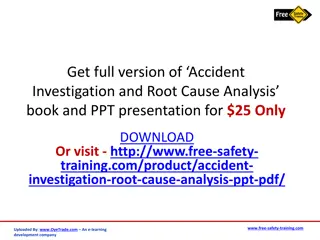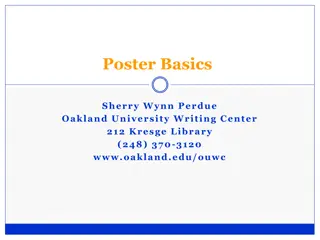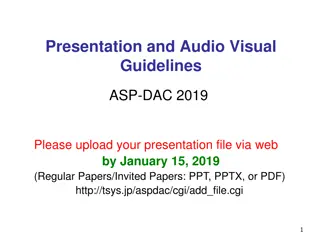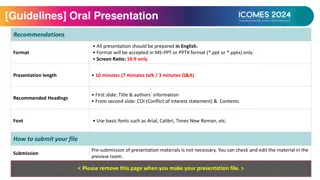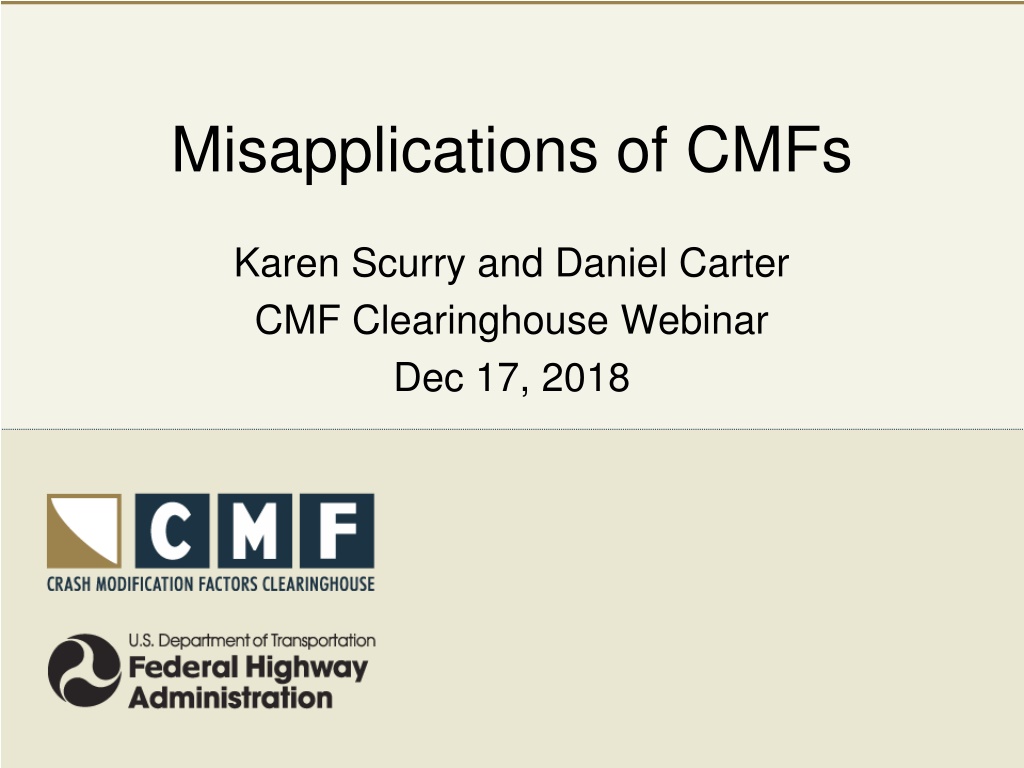
CMF Misapplications: Examples and Risks
Learn about the misapplications of Crash Modification Factors (CMFs) and how they can impact road safety outcomes. Discover common errors in calculating and applying CMFs, and understand the importance of using these factors correctly to improve crash rates. Get insights from real encounters and expert guidance to avoid CMF misapplications in road safety engineering projects.
Download Presentation

Please find below an Image/Link to download the presentation.
The content on the website is provided AS IS for your information and personal use only. It may not be sold, licensed, or shared on other websites without obtaining consent from the author. If you encounter any issues during the download, it is possible that the publisher has removed the file from their server.
You are allowed to download the files provided on this website for personal or commercial use, subject to the condition that they are used lawfully. All files are the property of their respective owners.
The content on the website is provided AS IS for your information and personal use only. It may not be sold, licensed, or shared on other websites without obtaining consent from the author.
E N D
Presentation Transcript
Misapplications of CMFs Karen Scurry and Daniel Carter CMF Clearinghouse Webinar Dec 17, 2018
Introduction Selecting an appropriate CMF is important information on previous webinar Applying CMFs correctly is important as well can have large impact on results CMF Clearinghouse team is available to help explain CMFs on the site or from a study report Examples of misapplications
CMF Misapplications Clearly right Clearly wrong In an ideal world, it would always be obvious when CMFs were applied correctly and when they were applied incorrectly.
CMF Misapplications Clearly right Clearly wrong Major concerns Minor concerns In reality, there is often a grey area, where CMFs might have been applied appropriately, but the application may have some minor or major concerns.
CMF Misapplications 1. Calculating CMF incorrectly 2. Applying CMF to wrong crash type 3. Inappropriately applying CMFs as SPF adjustment factors 4. Applying too many CMFs without accounting for interrelationship of effect
CMF Misapplications All examples based on real encounters Names and numbers changed to protect the innocent (or guilty)
Calculating CMF Incorrectly An engineer considered realigning an intersection from the current 75 degree angle to 90 degrees
Calculating CMF Incorrectly Research study indicates a CMF of 1.48 for a 75 degree intersection compared to a 90 degree intersection Engineer s question: Would it be logical to assume if this intersection was realigned to 90 degrees that the crash rate would then drop by 52 percent?
Calculating CMF Incorrectly Clearly wrong
Calculating CMF Incorrectly Mistake: assuming that a 1.48 CMF would lead to a 52% reduction in crashes (presumably because 2.0-1.48=0.52?) CMF = (CMF for new condition) / (CMF for old condition) = (CMF for 90 degrees) / (CMF for 75 degrees) = 1.00 / 1.48 = 0.68. This represents an expected 32% reduction in crashes (100-100x0.68 = 32), not 52%
APPLYING CMF TO WRONG CRASH TYPE
Applying CMF to Wrong Crash Type Situation: Deficient vertical curve (K value that does not meet AASHTO design standard) Observed 5-year crash history shows 50 crashes (0 fatal, 3 A-injury, 5 B-injury, 15 C-injury, 27 PDO) Engineer determines that 10 of these crashes (2 per year) are related to the vertical curve design
Applying CMF to Wrong Crash Type Engineer identified a CMF of 0.49 for improving vertical alignment. As shown below, the CMF applies to KABC crashes of all types.
Applying CMF to Wrong Crash Type Engineer applied the CMF to the identified target crashes 2 average crashes per year x 0.49 = 1 average crashes per year after realignment Benefit was calculated as preventing 1 target crash per year
Applying CMF to Wrong Crash Type Clearly wrong
Applying CMF to Wrong Crash Type To apply correctly: apply the CMF to the KABC crashes. 3 A-injury, 5 B-injury, 15 C-injury over 5 years = 4.6 KABC crashes per year 4.6 x 0.49 = 2.3 KABC average crashes per year after realignment Benefit is preventing 2.3 KABC crashes per year NOTE: It would be better to use SPF and EB adjustment to calculate expected crashes instead of using observed crashes
INAPPROPRIATELY APPLYING CMFSAS SPF ADJUSTMENT FACTORS
Inappropriately Applying CMFs as SPF Adjustment Factors Sometimes site characteristics or desired changes are not accounted for in SPFs Standalone CMFs can be used to adjust predicted results, however Must match base conditions Site characteristics Crash type distributions Must not overapply multiple CMFs
Inappropriately Applying CMFs as SPF Adjustment Factors An agency was weighing options for widespread safety enhancements and the anticipated benefits Analysts used CMFs to adjust crash predictions for many locations across the agency s jurisdiction CMFs came from standalone countermeasures featured in the Clearinghouse
Inappropriately Applying CMFs as SPF Adjustment Factors Major concerns Minor concerns
Inappropriately Applying CMFs as SPF Adjustment Factors Could be appropriate at some locations but inappropriate at others Most of the anticipated benefit came from estimates from standalone CMFs rather than factors in the SPF
Inappropriately Applying CMFs as SPF Adjustment Factors Standalone CMFs may not have matched base condition of the SPF in terms of site characteristics Standalone CMFs may not have been a good match to some sites based on crash type patterns If a countermeasure was intended for a target crash type, but the author reported a CMF developed for total crashes Would likely have a different effect on total crashes if applied at a location with a substantially lower proportion of the target crash type
Inappropriately Applying CMFs as SPF Adjustment Factors Potential for overreach in applying standalone CMFs (i.e., over estimating benefit of treatments by applying too many CMFs)
APPLYINGTOOMANY CMFS WITHOUTACCOUNTINGFOR INTERRELATIONSHIPOFEFFECT
Applying too many CMFs without accounting for interrelationship of effect A state agency created a spreadsheet for calculating the anticipated benefits of safety projects The form allowed 10 countermeasures to be included, each with its own CMF In this tool, each CMF would contribute to the anticipated crash reduction
Applying too many CMFs without accounting for interrelationship of effect Major concerns
Applying too many CMFs without accounting for interrelationship of effect CMFs may address the same crash type For example, addressing run off road crashes at curves Chevrons Wider edgelines High friction surfacing The effects are related (not independent)
Applying too many CMFs without accounting for interrelationship of effect Multiplying CMFs together likely overstates benefit, especially when considering many countermeasures A tool (or analyst) must account for interrelationship of effect Conservative approach: Use CMF from only the most effective treatment More guidance forthcoming in the Highway Safety Manual, 2nd edition using results from NCHRP 17-63













